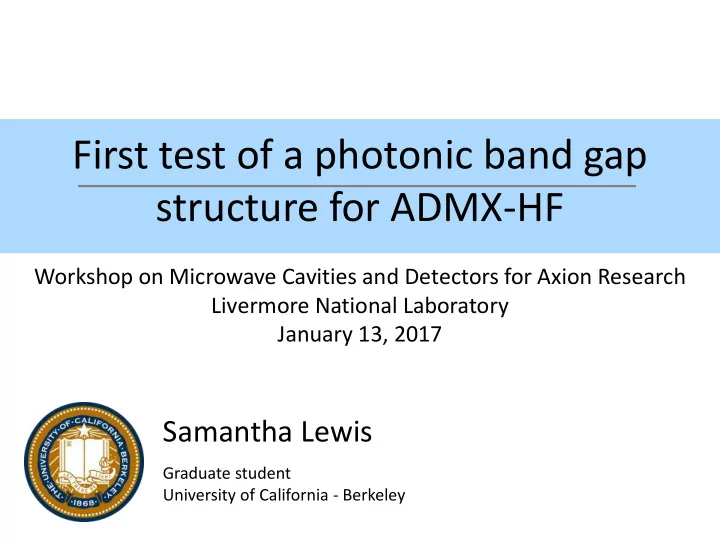

First test of a photonic band gap structure for ADMX-HF Workshop on Microwave Cavities and Detectors for Axion Research Livermore National Laboratory January 13, 2017 Samantha Lewis Graduate student University of California - Berkeley
Outline I. Background and motivation II. Prototype design III. Fixed frequency results IV. Discussion and future work
Background and motivation Photonic band gap structures • Periodic lattice of metal and/or dielectric rods • Open boundary (not enclosed) • Bands of frequencies which cannot propagate • Desired modes can be isolated using defect in lattice
Background and motivation Motivation • Eliminate mode crossings – Mode crossings reduce scan rate and make some tuning regions effectively unusable • Move to higher frequencies – Lots of design parameters and flexibility • Potential for high Q
Background and motivation Simple lattice configurations Triangular lattice Square lattice
Background and motivation Band gap maps Square lattice Triangular lattice Adapted from: Smirnova, et al ., J. Appl. Phys., 2002 TM modes Disallowed region TE modes Disallowed regions
Prototype design
Prototype design Lattice parameters • Densely packed lattice TM modes • Large rods (quarter inch OD) for structural stability • Defect formed from removing multiple periods • Goal maximum frequency: TE modes TE roughly 10 GHz TM 010 TM 010 • Starting length: 10 cm
Prototype design Tuning • Single metal tuning rod in defect • Tunes via the same mechanism as existing cavity (off-axis axle, 180 degree rotation) • Roughly 2.2 GHz in tuning total Note: tuning curve for a slightly different lattice
Prototype design TM 010 -like mode in simulation Maximum tuning position: 9.434 GHz
Prototype design Spectrum at top tuning position TM 010 -like mode No TE modes, two TEM modes found with field probes but not S 21
Prototype design Comparison with cavity • Cylindrical cavity with the same size tuning rod • Volume: roughly 0.2 L Size of “equivalent” cavity
Prototype design Comparison with cavity Cavity TM 010 -like mode
Fixed frequency results
Fixed frequency results Assembled structure • Fixed frequency tests first, no tuning rod • Tuning rod will be added to the same structure later • Made of 7075 aluminum
Fixed frequency results Simulated vs measured S 21
Fixed frequency results Measurement status • Measured Q value was 7,000, vs 17,000 simulated – Likely somewhat due to haphazard setup: poor connection with antennas – Simulation does not include the holes in the endcaps for access ports and the tuning rod axle – Simulation includes absorber outside the structure which we plan to use – Worst case: poor electrical contact within the structure • Frequencies of the three modes were almost exactly as expected (less than 0.15% difference in all cases)
Discussion and future work
Discussion and future work Fixed frequency device • Narrow down the discrepancy in Q – Take more thorough measurements – Incorporate all features of the design into the simulation • Bead pull measurements – Verify all three modes are what we expect – Check the flatness of the profile
Discussion and future work Tuning measurements • Fabricate and add the tuning rod – Requires disassembly and reassembly, allowing for a full cleaning of the structure • Bead pull measurements – Look for unexpected modes – Study the potential TEM mode crossing – Validate full simulations of the tuning curve – Make a complete mode map
Discussion and future work Summary • Fabricated a fixed frequency PBG to validate our simulations • Tuning rod to be implemented by the end of the month • Extensive study planned to examine the single tuning rod method • Knowledge will be used to investigate other designs, including higher Q and other frequencies
ADMX-HF/X3 Team Yale University (experiment site) Steve Lamoreaux, Ling Zhong, Ben Brubaker, Sid Cahn, Kelly Backes UC Berkeley Karl van Bibber, Maria Simanovskaia, Samantha Lewis, Jaben Root, Saad Al Kenany, Nicholas Rapidis, Isabella Urdinaran CU Boulder/JILA Konrad W. Lehnert, Daniel Palken, William F. Kindel, Maxime Malnou Lawrence Livermore National Lab Gianpaolo Carosi, Tim Shokair
Questions?
Recommend
More recommend